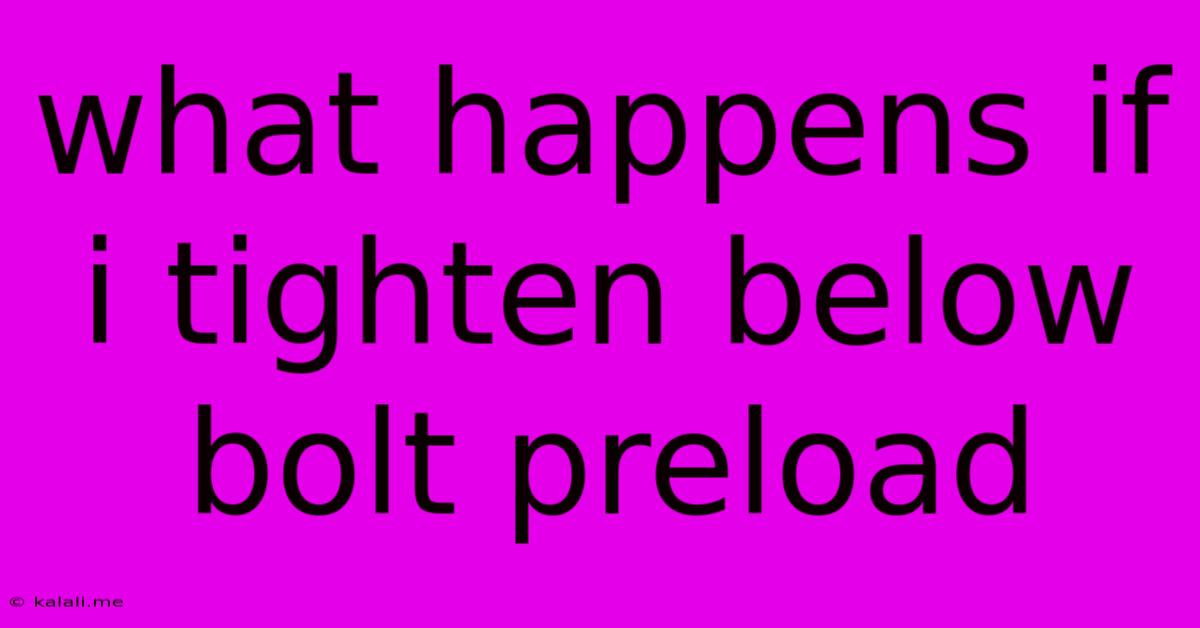What Happens If I Tighten Below Bolt Preload
Kalali
Jun 05, 2025 · 3 min read

Table of Contents
What Happens if I Tighten Below Bolt Preload?
Meta Description: Discover the consequences of under-tightening bolts – from reduced clamping force and potential component failure to safety risks and costly repairs. Learn the importance of achieving proper bolt preload for optimal performance and longevity.
Bolts are fundamental to countless mechanical assemblies, from simple household appliances to complex industrial machinery. Their primary function isn't just holding things together; it's to maintain a specific clamping force, known as preload, between the joined components. Tightening a bolt below its specified preload has far-reaching negative consequences that can range from minor inconvenience to catastrophic failure. This article explores the ramifications of under-tightening and emphasizes the importance of achieving the correct preload.
Reduced Clamping Force: The Primary Effect
The most immediate consequence of under-tightening is a reduced clamping force. The preload is what keeps the joined parts firmly compressed. Insufficient preload means the components aren't held together as tightly as they should be. This can lead to:
- Vibration loosening: Vibrations, even minor ones, can cause the components to shift, leading to a gradual loss of clamping force and eventually complete separation. This is particularly problematic in applications subject to significant dynamic forces.
- Leakage: In sealed systems, inadequate clamping force can lead to leaks. This is crucial in applications involving fluids, gases, or even vacuums. A seemingly small leak can have significant consequences, from fluid loss to complete system failure.
- Increased Wear and Tear: Insufficient clamping pressure increases friction and relative movement between components, leading to premature wear and tear. This accelerates the deterioration of parts, potentially requiring expensive and time-consuming replacements.
Component Failure and Safety Risks
Beyond the immediate issues, under-tightening can contribute to serious component failures and pose safety risks.
- Fatigue Failure: Repeated cyclical loading, even within the normal operational range, can cause fatigue cracks and eventual fracture if the clamping force is insufficient. This is especially critical in high-stress applications.
- Structural Weakness: Under-tightening weakens the entire assembly, making it more susceptible to damage from external forces. This compromise in structural integrity can lead to unexpected failure, potentially resulting in injury or equipment damage.
- Safety Hazards: In critical applications like automotive or aerospace engineering, insufficient bolt preload can have catastrophic consequences. Failure of a critical bolt can lead to accidents with severe safety implications.
Identifying and Preventing Under-Tightening
Proper torque wrench usage is paramount in preventing under-tightening. However, even with the right tool, several factors can contribute to insufficient preload:
- Lubrication: Using the wrong type or amount of lubricant can significantly affect the torque required to achieve the desired preload. Always consult the manufacturer's specifications.
- Bolt Material and Condition: Damaged or corroded bolts may not achieve the correct preload even with proper torque application. Inspect bolts for damage before tightening.
- Thread Engagement: Ensure the bolt is fully engaged in the nut or tapped hole. Insufficient thread engagement can lead to inaccurate torque readings and reduced clamping force.
Achieving proper bolt preload is essential for the longevity, reliability, and safety of any bolted assembly. Using the correct torque wrench, adhering to manufacturer specifications, and understanding the potential consequences of under-tightening are crucial steps in ensuring the structural integrity and safety of your project. If you are unsure about the correct procedure, consult a qualified engineer or technician.
Latest Posts
Latest Posts
-
How To Check Indexes On A Table In Sql Server
Jun 06, 2025
-
Tyrion Lannister Going To The Wall
Jun 06, 2025
-
Did Jesus Say He Died For Our Sins
Jun 06, 2025
-
Was Mary Born Without Original Sin
Jun 06, 2025
-
What Do Roaches Do For The Environment
Jun 06, 2025
Related Post
Thank you for visiting our website which covers about What Happens If I Tighten Below Bolt Preload . We hope the information provided has been useful to you. Feel free to contact us if you have any questions or need further assistance. See you next time and don't miss to bookmark.